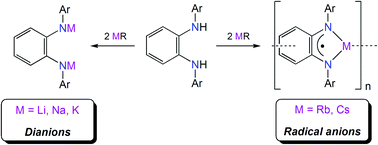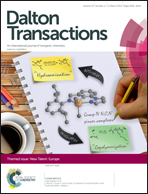Alkali metal derivatives of an ortho-phenylene diamine†
Abstract
Treatment of the ortho-phenylene diamine C6H4-1,2-{N(H)Tripp}2 (1, PDAH2, Tripp = 2,4,6-triisopropylphenyl) with two equivalents of MR (M = Li, R = Bun; M = Na or K, R = CH2C6H5) afforded the dimetallated alkali metal ortho-phenylene diamide dianion complexes [(PDALi2)(THF)3] (2), [{(PDANa2)(THF)2}2] (3), and [{(PDAK2)(THF)3}2] (4). In contrast, treatment of 2 with two equivalents of rubidium or cesium 2-ethylhexoxide, or treatment of 1 with two equivalents of MR (M = Rb or Cs, R = CH2C6H5) did not afford the anticipated dialkali metal ortho-phenylene diamide dianion derivatives and instead formally afforded the monometallic ortho-diiminosemiquinonate radical anion species [PDAM] (M = Rb, 5; M = Cs, 6). The structure of 2 is monomeric with one lithium coordinated to the two nitrogen centres and the other lithium η4-coordinated to the diazabutadiene portion of the PDA scaffold. Similar structural cores are observed for 3 and 4, except that the larger sodium and potassium ions give dimeric structures linked by multi-hapto interactions from the PDA backbone phenyl ring to an alkali metal centre. Complex 5 was not characterised in the solid state, but the structure of 6 reveals coordination of cesium ions to both PDA amide centres and multi-hapto interactions to a PDA backbone phenyl ring in the next unit to generate a one-dimensional polymer. Complexes 2–6 have been variously characterised by X-ray crystallography, multi-nuclear NMR, FTIR, and EPR spectroscopies, and CHN microanalyses.

- This article is part of the themed collection: New Talent: Europe

 Please wait while we load your content...
Please wait while we load your content...